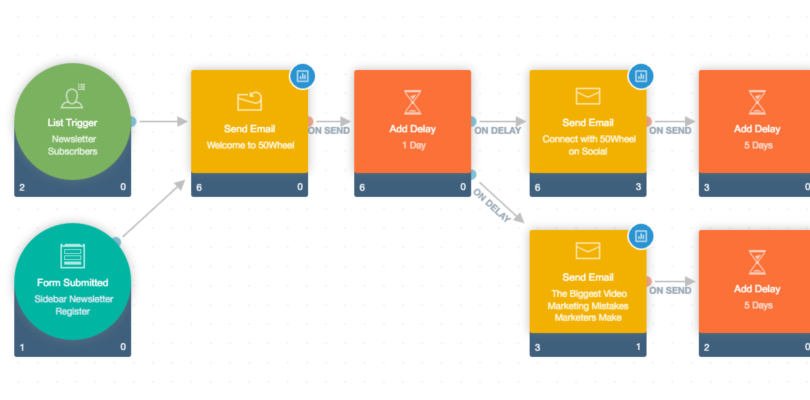Once you have established email nurture programs you can then look at bringing video into your emails and messaging to help increase the effectiveness of your campaigns. To learn more about the basics of integrating video with your marketing automation platform read our article about connecting video to marketing automation.
 Before you set off and start designing a video nurture program you need to do an inventory check of your video content. This may mean watching each video and organizing the content into relevant categories. By organizing the content you will not only uncover opportunities to enhance existing messaging with video, but also start building a library of content that will play a critical role in defining your workflow.
Before you set off and start designing a video nurture program you need to do an inventory check of your video content. This may mean watching each video and organizing the content into relevant categories. By organizing the content you will not only uncover opportunities to enhance existing messaging with video, but also start building a library of content that will play a critical role in defining your workflow.
Now that you have your content inventory organized its time to you at your existing buyer journey and life cycle or funnel, however you look it. To get the full picture ask yourself some questions:
1. How many new customers does your company win monthly and where do they come from? Understanding where new customers are coming from and how many are generated each month will help to determine the scale of video content production you need to need to factor in. You can get to this information a couple of ways, check with marketing or sales, run a report in your CRM. Monthly new customers has an impact on how many nurture segments you create and the frequency of communication, since you might need to speak to different audiences at different times.
2. What types of products or services does your company provide? Some companies market a single product line, others market large catalogs of products and services. Your company’s product range determines the number of nurture tracks in your campaign.
3. What are your key audience personas? How different are your customers from one another in terms of job title, industry vertical, annual revenue, etc..? Do these persona groups require different messaging? The more personas you are working with, the more likely it is that you need build out separate nurture tracks for your campaigns to be relevant and effective.
4. Describe the buyer’s journey. How are prospects and customers messaged to; engaging with content today? Having a clear understanding of the stages of the journey and how buyers will interact with each step will help fine tune your nurturing programs to have the most impact.
Your video nurture programs will need to have set goals for measuring success. What business results do you hope to achieve from setting up video nurture tracks?
Consider the following goals:
- Increase the pace of the buyer’s journey over time
- Use video to further engage buyers along the journey
- Educate and build trust with existing customers and accounts
- Get deep insights into buyer behavior through video marketing
- Increase customer adoption and account growth
Each goal will differ depending on the business use case. Setting goals will help you make better decisions on timing, frequency, and segmentation.
Set measurable goals. You can do this even if you don’t yet have the metrics — estimates in the beginning will help determine your campaigns in the future. Setting metrics will not only help measure success, but determine the scope and scale of your overall video nurturing efforts.
Start simple and scale
The possibilities are endless when video is integrated with marketing automation. There are so many benefits, but getting up and running can be somewhat of a mystery. If you are beginning with your first nurture campaign, you should create a plan that includes a phased approach. Doing this will allow you to incrementally measure and improve along the way.
The benefits of simplifying your launch:
Launch on a short timeline: The smaller the campaign, the faster you’ll go live, and the sooner you will see ROI.
Recognize what’s working: The results might not turn out how you expected. Keep notes on what’s working and what’s a dead end. Examine what works and iterate often.
To include video in your nurture emails you will need to employ a premium video hosting solution or video marketing platform that integrates with your marketing automation software and CRM. These technologies integrated are becoming an essential pair for any modern marketing department. Once integrated, video can be used across all nurturing use cases, including, engagement, conversion, and personalization scenarios.
How do you select the right video marketing solution for your business? Depending on your objectives and goals, there are different solutions available to suit your needs. Here is a process you can follow to evaluate and purchase a video marketing solution that is right for your organization.
Step 1: Write down your goals for the project: To be successful you need to write down your goals. What do you hope to achieve by bringing video into your campaigns? Reference to the examples above.
Step 2: Plan your timeline: Identify the steps it will take you to get to your goal. How long will it take you to accomplish each step? If successful, video nurture campaigns will be ongoing, so you can expect to adapt and from learn along the way.
Step 3: Identify your requirements: Selecting the right video marketing solution involves more than just picking the right technology. Think beyond the software and more about your business case — who will use the technology, and how?
Step 4: Put together a team to select and manage the solution: Gather a team to evaluate video marketing platforms and build a plan to get signoff from all stakeholders on goals, requirements, and potential deployment scenarios. [See our guide on selling video marketing to your executives]
Step 5: Evaluate potential vendors: Pick at least 3 vendors that appear to fit your needs based on assembled requirements. Carefully evaluate each technology, dig deep and speak with account teams, ask tough questions, and avoid a feature bake-off type scenarios.
Step 6: Get references: Once you have selected a specific vendor, you will want to look for proof of past success. Talk to at least 3 references that use the software in a similar use case to how your company intends on using it.
Step 7: Make a decision: If the references check out okay, choose the vendor order that will help you achieve your outlined goals.
Video marketing platforms have very specific components needed to be successful with video nurturing campaigns. Here is a checklist of solution features needed to make a lasting impression on the revenue numbers. Make sure your selection has these:
☐ Enables you to build video players that track individual viewing behaviors in real time to compile a digital body language profile. It’s import to make sure your video hosting solution has the APIs that support 2-way conversations with your buyers.
☐ Enables you to send and assign video viewing behavior to contacts in your marketing automation platform and CRM. Modern video hosting solutions have the capabilities to track and assign individual video viewing events to specific contacts in a CRM database.
☐ Enables you to add in-video call-to-actions such as forms and annotations. You want to make sure you can capture and convert traffic from your videos. Some video marketing solutions provide the ability to build or drop forms in the video player that appear at specific assigned points during video playback. It’s important to make sure this feature integrates with your MAP and CRM.
☐ Enables you to personalize the experience. The video marketing solution should enable you to have control over the video you present to the viewer based on the recipient’s actions to date. These can be website behavior like reading your blog or speaking to someone on from your company on the phone. Personalizing the experience helps build tighter relationships over the entire buyer journey.
☐ Enables measurement of success. The solution should provide analytics that help you measure the success of your campaigns both on an aggregate level but also down to the individual video viewer.
☐ Out of the box. Your video marketing solution should not have to rely on the IT department to be successful. The solution should allow a marketer to create powerful video marketing campaigns that are easy to setup and manage.
It’s important not to think of your video marketing separately from the rest of your content programs. Frequently reference your content calendar to determine what other communication touches video can fit into and enhance. You are sending out newsletters, product updates, emails, and other cross-channel communications that include video. How is video impacting each one?
The other most important success factor in video nurture campaigns is how often you send communications. When you are communicating via email it’s import to be conscious of how often you hit your marketing database with other communications outside of the nurture. To get this right, determine a communication cadence. How often are you engaging with the customers in your database?
It’s a good idea to meet with stakeholders to decide what this should look like. Like everything else, make sure to test and iterate over time. The length of the buying process will impact the timing of your nurturing campaign.
To browse video marketing platforms that integrate with MAPs and CRMs click here.


